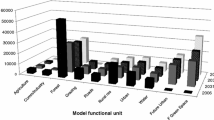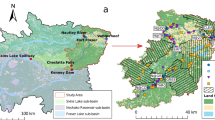Abstract
Presque Isle Bay is one of 40 remaining environmental areas of concern (AoCs) on the North American Great Lakes that have one or more water, habitat, or sediment quality impairments as defined by the International Joint Commission. In situ natural capping using sediment from to-be-remediated watersheds and other potential sources is being considered as the most feasible means of remediating an existing contaminated sediment problem at this site. A multi-decade (∼40 year) sediment budget shows that, when localized anthropogenic effects (dredging, reclamation) are discounted, the bay net-accumulated sediment over time. Sediment was supplied from three major sources: bank erosion and bluff retreat (41%), streams (25%), and the Lake Erie littoral system (20%). The non-stream sources supply environmentally clean materials from ancient beach and glacio-lacustrine deposits along the shoreline, and from the modern littoral system. Organic and metallic contaminants supplied primarily by streams and run-off remain a remediation challenge for the AoC. Geologically, natural capping of contaminants over the next several decades is a viable solution for most of the bay. The mechanism may not work effectively in all areas because approximately 25% of the bay floor is moderately net-erosional while several localized areas accumulate sediments very slowly at decadal timescales.






Similar content being viewed by others
References
Battelle (1994) Evaluation of polycyclic aromatic hydrocarbons in Presque Isle Bay sediment cores for may 1994 study. Battelle Ocean Sciences, Duxbury
Battelle (1997) Presque Isle Bay sediment study—data review: final report. Battelle Ocean Sciences, Duxbury
Blust FA (1972) History and theory of datum planes of the Great Lakes. Int Hydrogr Rev 49:109–121
Cahoon DR, Marin PE, Black BK, Lynch JC (2000) A method for measuring vertical accretion, elevation and compaction of soft, shallow-water sediments. J Sediment Res 70:1250–1253
Colman SM, Foster DS (1994) A sediment budget for Southern Lake Michigan: source and sink models for different time intervals. J Great Lakes Res 20:215–228
Comoss EJ, Kelly DA, Leslie HZ (2002) Innovative erosion control involving the beneficial use of dredge material, indigenous vegetation and landscaping along the Lake Erie shoreline. Ecol Eng 19:203–210
Dean We Jr (1974) Determination of carbonate and organic matter in calcareous sediments and sedimentary rocks by loss on ignition: comparison with other methods. J Sediment Petrol 44:242–248
Diz HR (2005) An assessment of sediment contamination in Presque Isle Bay, PA, with historical comparisons. J Aquat Ecosyst Health Manage 8:21–31
Diz HR, Bruno T, Hudson J (2003) A hydrologic and water quality study of Cascade Creek, Erie, Pennsylvania: final report, Erie-Western Pennsylvania Port Authority, Pennsylvania Growing Greener Program, Pennsylvania Department of Environmental Protection, and the Great Lakes Commission, Erie, PA
Diz HR, Bruno T, Hudson J, Katta-Muddana M (2004) Sediment transport modeling of Mill Creek and Cascade Creek in Erie, Pennsylvania: final report, US Army Corps of Engineers, Buffalo District, Buffalo NY
Dokka RK (2006) Modern day tectonic subsidence in coastal Louisiana. Geology 34:281–284
EPA (1998) Realizing remediation: a summary of contaminated sediment remediation activities in the Great Lakes Basin. US Environmental Protection Agency, Great Lakes National Program Office, Chicago, IL
EPA (2005) Sediment remediation projects in Great Lakes Areas of Concern. US Environmental Protection Agency. http://www.epa.gov/glnpo/aoc/sedimentprojects.html. Cited July 2006
Foyle AM, Norton KP (2005) Historical sediment dispersal along open-lake shoreface and protected back-bay environments, Presque Isle, Pennsylvania: natural and anthropogenic influences. In: Paper presented at the 2nd international coastal symposium, Hofn, Iceland, 15 pp. http://www.itv.is/ics2005/Abstracts_%20papers.htm. Cited August 2006
Foyle AM, Norton kP (2006) Late Holocene nearshore change at a non-tidal transgressive systems tract strandplain system, Presque Isle, Pennsylvania, USA. J Coast Res 22:406–423
Foyle AM, Norton KP, Mattson JP (2006) Deciphering the 20th century sedimentary regime in Presque Isle Bay (AOC 43), Lake Erie. In: Paper presented at the 49th annual meeting of the international association for great lakes research, Windsor, ON, Canada, May 22–26, 2006
Gaffney FB, Lake DW (2003) New York standards and specifications for erosion and sediment control. http://www.dec.state.ny.us/website/dow/toolbox/escstandards/index.html. Cited April 2006
Galvin C (2001) Apparent sea-level rise caused by sediment compaction. In: Paper presented at the Geological Society of America annual meeting, Boston, MA, USA, November 1–10, 2006
Gorecki RJ, Pope J (1993) Coastal geologic and engineering history of Presque Isle, Pennsylvania. US Army Corps of Engineers, Waterways Experiment Station Miscellaneous Paper CERC-93–8. US Army Corps of Engineers, Vicksburg, MS
Heiri O, Lotter AF, Lemcke G (2001) Loss on ignition as a method for estimating organic and carbonate content in sediments: reproducibility and comparability of results. J Paleolimnol 25:101–110
Jennings OE (1930) Peregrinating Presque Isle. Carnegie Mag 4:171–175
Kana TW (1995) A mesoscale sediment budget for Long Island, New York. Mar Geol 126:87–110
Komar PD (1998) Beach processes and sedimentation, 2nd edn. Upper Saddle River, Prentice-Hall, Inc, 544 p
Larsen CE (1985) Lake level, uplift, and outlet incision, the Nipissing and Algoma Great Lakes. In: Karrow PF, Calkin PE (eds) Quaternary evolution of the Great Lakes, GAC special paper 30. Geological Association of Canada, St. John’s, Newfoundland, Canada, pp 63–77
Moore LJ (2000) Shoreline mapping techniques. J Coast Res 16:111–124
NOAA (2005) Historic maps and charts. http://www.chartmaker.ncd.noaa.gov/staff/charts.htm. Cited August 2006
Nummedal D, Sonnenfeld DL, Taylor K (1984) Sediment transport and morphology at the surf zone of Presque Isle, Lake Erie, PA. Mar Geol 60:99–122
O’Brien MK, Valverde HR, Trembanis AC, Haddad TC (1999) Summary of beach nourishment activity along the Great Lakes’ shoreline 1955–1996. J Coast Res 15(1):206–219
Potomac-Hudson Engineering, Inc. (1991) Presque Isle Bay ecosystem study: background report. Pennsylvania Department of Environmental Resources, Meadville
Rosati JD (2005) Concepts in sediment budgets. J Coast Res 21:307–322
Rybczyk JM, Cahoon DR (2002) Estimating the potential for submergence for two wetlands in the Mississippi River. Estuaries 25:985–998
Santisteban JI, Mediavilla R, Lopez-Pamo E, Dabrio CJ, Ruiz Zapata MB, Gil Garcia MJ, Castano S, Mertinez-Alfaro PE (2004) Loss on ignition: a qualitative or quantitative method for organic matter and carbonate mineral content in sediments. J Paleolimnol 32:287–299
Sellinger CE, Quinn FH (1999) Great Lakes Paleo-levels workshop: the last 4000 years. NOAA Technical Memorandum ERL GLERL-113. Great Lakes Environmental Research Laboratory, Ann Arbor, MI, 43 pp
Sommerfield CK, Nittrouer CA (1999) Modern accumulation rates and a sediment budget for the Eel shelf: a flood-dominated depositional shelf. Mar Geol 154:227–241
Urban Engineers, Inc. (2004) Shoreline stabilization and erosion control: Lake Erie Cliff Erosion Protection Demonstration Project, Ferncliff Park, Erie, Pennsylvania. Erie-Western Pennsylvania Port Authority, Erie, PA
US Army Corps of Engineers (1980) Presque Isle, Pennsylvania, Erie, PA. Final phase I general design memorandum, including environmental impact statement. US Army Corps of Engineers, Buffalo District, Buffalo, NY
US Army Corps of Engineers (1998) Department of the Army, annual report fiscal year 1998 of the Secretary of the Army On Civil Works Activities, Buffalo District, Erie Harbor, PA. US Army Corps of Engineers, Buffalo District, Buffalo, NY
US Army Corps of Engineers (2002) Engineering manual EM 1110-2-1003: engineering and design—hydrographic surveying. US Army Corps of Engineers, Washington, DC
US Army Corps of Engineers (2005) Great Lakes water levels. http://www.lre.usace.army.mil/greatlakes/hh/greatlakeswaterlevels. Cited August 2006
Williams H (2003) Modeling shallow autocompaction in coastal marshes using Cesium-137 fallout: preliminary results from the Trinity River estuary, Texas. J Coast Res 19:180–188
Acknowledgments
Partial funding for this project was provided by the Great Lakes Commission—Great Lakes Basin Program for Soil Erosion and Sediment Control. We appreciate the assistance of undergraduate student Jamie P. Mattson during sample analyses, and Presque Isle State Park and Pennsylvania Sea Grant personnel during data collection.
Author information
Authors and Affiliations
Corresponding author
Rights and permissions
About this article
Cite this article
Foyle, A.M., Norton, K.P. Geo-feasibility of in situ sediment capping in a Great Lakes urban estuary: a sediment budget assessment. Environ Geol 53, 271–282 (2007). https://doi.org/10.1007/s00254-007-0641-x
Received:
Accepted:
Published:
Issue Date:
DOI: https://doi.org/10.1007/s00254-007-0641-x




